100th Anniversary Great Nave Tour at the Cathedral of St. John the Divine
Celebrate the 1925 construction of the stunning nave inside the world's largest Gothic cathedral!


In the latest installation of NYC Makers, our column profiling New York City’s movers and shakers, we had the pleasure of sitting down with NYC Parks Commissioner Mitchell Silver at his office in the Central Park Arsenal. Silver has served as Parks Commissioner since 2014 and just celebrated the completion of nearly 650 capital projects in five years. No project is too small or large for Silver, and he imbues every project with a passion for equity and a zest for discovery. We also discovered a shared passion for getting to the tops of buildings as Silver shared his own personal New York City bucket list with us. And congratulations to him for completing his second New York City Marathon this past Sunday!
“You cannot have a great city without a great park system, to me that’s what makes New York City great.”
Mitchell Silver, NYC Parks Commissioner: Well, there are two, one happens to be canoeing the Bronx River. The Bronx River Alliance has a flotilla every year as part of their fundraiser and I went on the first flotilla. It’s a five mile canoe ride down the Bronx River. I was transformed to another place, but also got a chance to see what the Alliance was able to do over a twenty year period. You hear the story about how cars were in the river. It’s the only natural fresh water river we have in New York. But just to go from the top where we start, you go through the Bronx Zoo and you end up by Starlight Park, and it’s like where am I? That by far is something I tell everyone to experience. It’s the one thing I just enjoy doing every year. You can do shorter trips, but to do the full five miles takes several hours.
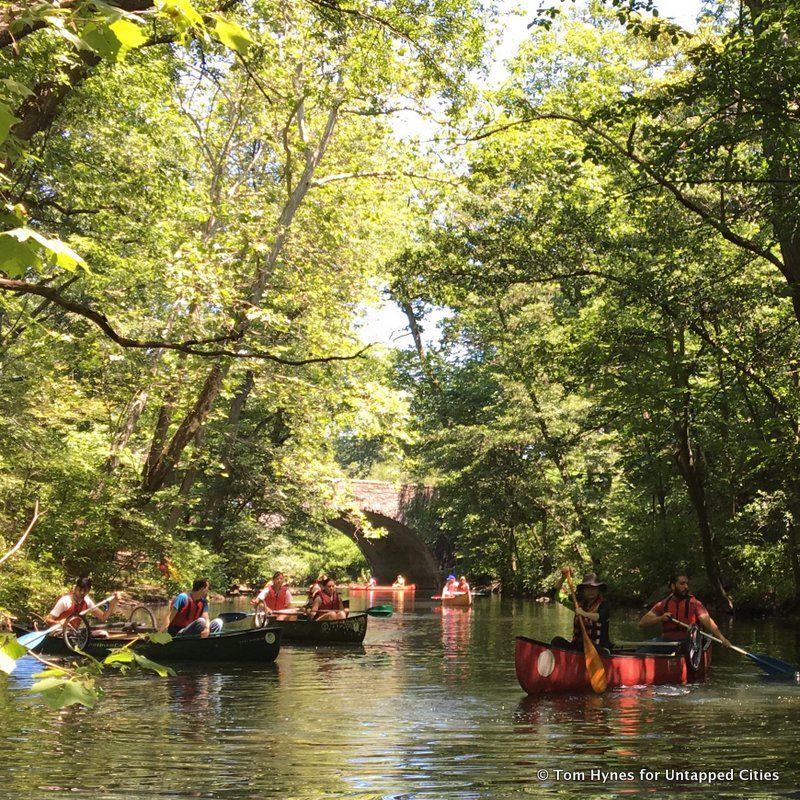
You can take a canoe trip with the Bronx River Alliance from June to November. Check the organization’s website for schedule.
The other spot is the Harlem Fire Watchtower. The restoration was just completed and I went on top and rang the bell for the first time in seventy years. I was just tingling all over. I had to ring it three times and do the fourth time. It’s an era gone by. But how well they were able to restore the fire watchtower and were able to do the upper Acropolis, it is just a very sacred space and it’s a park that people have got to go to and see. It’s just one of those hidden destinations like when the High Bridge reopened a few years ago, the must-see now is the fire watchtower!

Commissioner Silver: I do! They’re all on the top of. First, my favorite two skyscrapers. Growing up, being a student of architecture, the Chrysler Building and the Woolworth Building and believe it or not, the Municipal Building which is now the David Dinkins Building. I have this desire and passion to go to the top of each and every one of them. The Chrysler Building, a little more difficult, because of the top, but the Woolworth Building? Cass Gilbert was the architect, and I’m just dying to see what it’s like on the upper upper upper parts. And then the other top I’d like to go to is the Municipal Building. We went pretty high, but it has this very interesting top and I’m dying to see what is going on up there. And then the last one is the Washington Square Park Arch. I was able to go [to the top of] the Soldiers’ and Sailors’ Memorial Arch at Grand Army Plaza but I have not been able to go in Washington Square, to go on top of that one. So everything seems to be top: Municipal Building top, Woolworth Building top, and Washington Square top.
Michelle, Untapped New York: You’re very aligned with our readers on that. They’re always asking us about how to get to the top of the Woolworth. They’ve asked me about the Washington Square arch…
Here we chatted about how to make the Washington Square Park arch happen for Silver and Untapped New York readers. We’re holding you to that Commissioner Silver! ツ
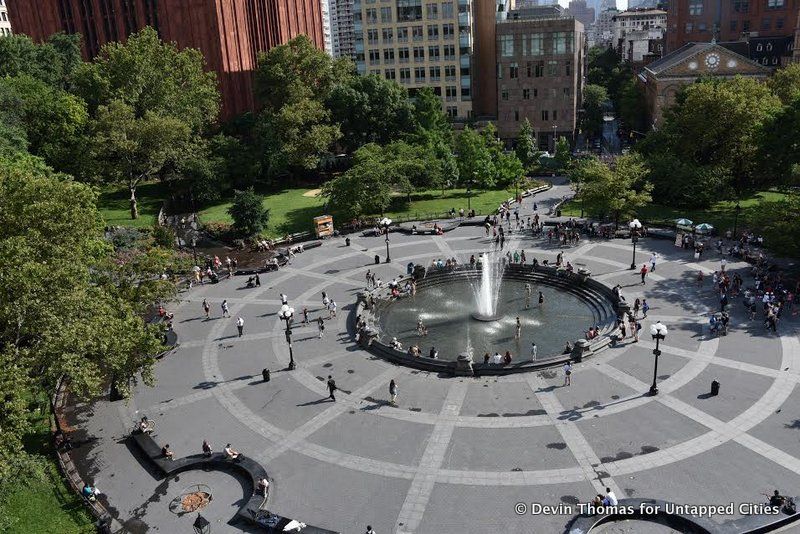
View from atop the Washington Square Park arch!
Commissioner Silver: This may not come as a surprise to you but to me, it’s our park system. I grew up in New York, moved away. And then I got recruited to come back. I’m a planner by training, and so to come back for parks, I wasn’t 100% sure. When I came back to visit, I never looked at parks as something I would manage. But I have to say, the evolution of New York City was really driven by the change in the park system. I grew up not having access to Brooklyn Bridge Park. I grew up not having access to the Hudson River, and to see this all opened up, giving the best land to the public, to me was transformative. Hunters Point South, Long Island City and its transformation…Brooklyn Bridge Park, I used to drive by the BQE, look down and just see this terminal shipyard. And [now] to have access to the water, to see the city views, I had never seen it before when I was growing up. That to me has led to the transformation we see… Governors Island, Roosevelt Island…The parks in general just really change the city. And to me that’s what I think is so special about New York. We’re a dense city, people don’t have front yards, backyards. And so the park serves not just for recreation, but also for mental health and for people to connect. And it’s so vital to the survival of the city. You cannot have a great city without a great park system, to me that’s what makes New York City great.
Michelle, Untapped New York: Totally agree, I feel like it made New York City really a world class city, opening up a lot of these parks that are really in the forefront for both visitors and the community.
Commissioner Silver: When I go to other cities you start to realize how having Central Park and other parks throughout the city really give that space where you can just relax for a second in this very dense busy city. So without a question to me, it’s the parks system [that makes New York City great].
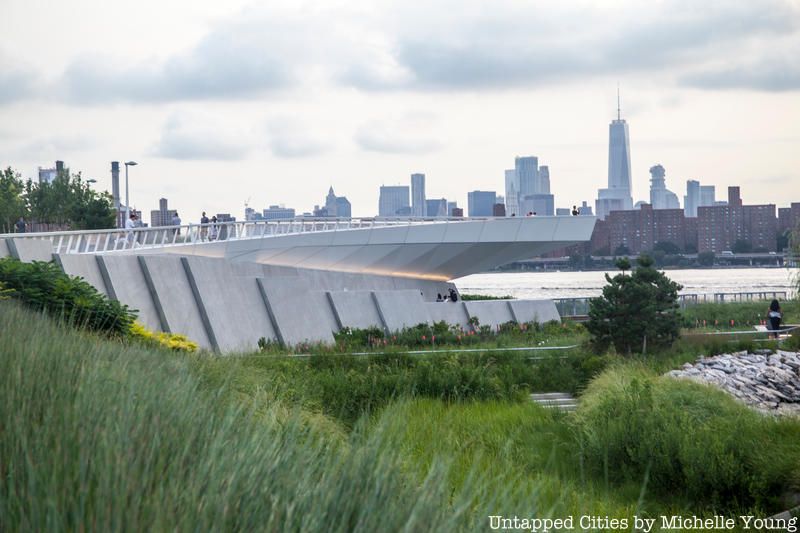
Hunters Point South Park
Commissioner Silver: I have the unique honor of fixing some of the things that Robert Moses didn’t get right. There are two Robert Moses’ in my opinion. There’s pre war [Robert Moses], who did a lot of great things for parks and for people, recognizing the needs of recreational outlets. Then there’s the post war, which was the highway Robert Moses. The post war Robert Moses created these highways, divided neighborhoods, and created these very weird leftover parks that really did not serve the public very well. So it’s my honor to take these asphalt dead spaces and bring them back to life.
But if I had to do it all over again, I’d create a very different system, something like Minneapolis which reserved the waterfront land first for the public. I would love to see a complete esplanade around the entire island of Manhattan and the other boroughs. Having access to the water, having those recreational opportunities, building the East River Esplanade right. On the west side, you have Hudson River Park running the entire span. On the east side, you don’t have a continuous esplanade and where it is, it’s very narrow. If I had to do it all over again, I would have set aside, like in Minneapolis, all that public land first, and then built the transportation system second so the public has access to the incredible open space along the waterfront. We’re a costal city, 525 miles of coastline. And I believe all that should be publicly accessible green space for recreation, access to water, access to greenways — elevating our city and make it more connected. So if I had a chance to do it right, I would start all over and give that best waterfront coastal land to the public.
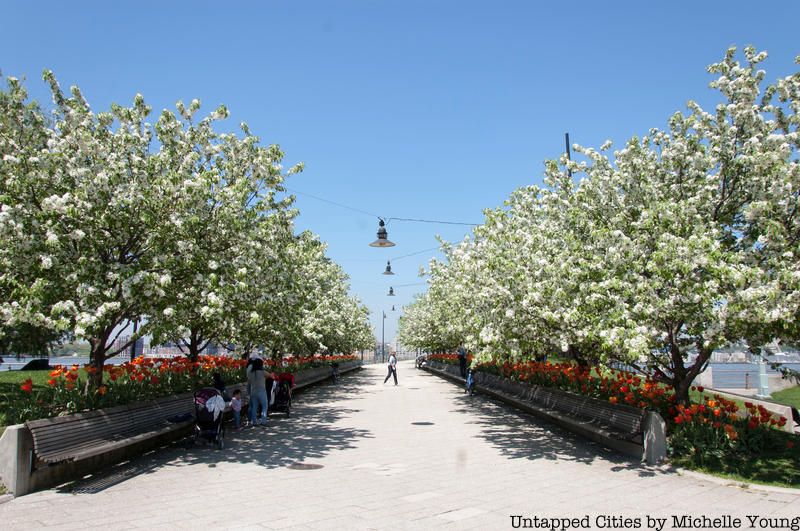
There was an initiative by the mayor to try to close the loop around Manhattan, and we’re now looking at the other boroughs. The good thing with the waterfront zoning is as we have development, we’re doing it piece by piece. But the wisdom of Minneapolis when the city was created is that they said no, all waterfront land is for the public. So we’re trying to retrofit that back, and it’s very expensive, but if I had to do it all over again, we’d start there.
“I guess if Robert Moses and Jane Jacobs had a child, it would probably be me.”
Commissioner Silver: I just started reading Palaces for the People by Eric Kleinenberg. I just picked it up. I’m very excited to read it — it’s about civic life, social justice. I’ve started a couple of pages. There’s a section on the High Line which I was like, “Oh cool!”.
In terms of television show, I just started watching Watchmen. It just came out last week. I’m a big fan of Regina King. She’s a star so I’m trying to watch the episodes but not quite getting it. So I watched episode one again and two last night, trying to give Watchmen a chance. However, Seven Seconds on Netflix, hands down is the best one season series pilot ever. I just love it.
Crystal Howard, Assistant Commissioner Communications for NYC Parks: I thought you were going to go to your tried and true…
Commissioner Silver: It’s not the same, it’s not the same.
Michelle, Untapped New York: The Walking Dead? I know, there are just so many seasons. It’s hard for shows to keep up, right?
Commissioner Silver: It went very soap-opera ish. It went from, I couldn’t wait for the next episode to now. I’ve watched all seasons and I’m now in this current season, episode four, and I can’t wait for it to be over.
Michelle, Untapped New York: Do you know what movie is coming out this weekend? Motherless Brooklyn.
Commissioner Silver: I heard about that, yeah.
Michelle, Untapped New York: There’s a Robert Moses character, thinly veiled as Moses Randall.
Commissioner Silver: I guess if Robert Moses and Jane Jacobs had a child, it would probably be me because I like the parks building [process], but I have sensitivity for how people really need to connect to public space. I really look at the soul of the place and make sure that we plan places for people. But I like the fact that [Robert Moses] is a master builder. We’ve done over 648 projects in the last five years. So that’s something. I love building things, but for the purpose of a focus on places for people and not just projects that remove neighborhoods and people and memories. I’d rather do it where it’s all done right.
Commissioner Silver: Well, certainly the Community Parks Initiative. It’s the one that gives me personal satisfaction, but also mostly it gives the community personal satisfaction even more than me. When I came on board, the mayor really wanted me to deal with this issue of equity. And we had a few months to come up with an approach and we decided to take a data driven analysis to find out how many of our parks in the last 20 years received little to no investment. The city spent over $6 billion over 20 years and when we did our analysis, we found that there were 215 parks within New York City that received little to no investment. And these are places that wouldn’t surprise you: South Bronx, Lower East Side, the tough parts of Brownsville in Brooklyn. And it was sad. So the mayor, to his credit, we were able to put together about $300 million to not just fix [the parks], but rip them down to the asphalt and dirt and rebuild them.
It has made such a difference in the communities where we have changed these parks. A man on Staten Island said, “What are you doing here I thought nobody cared?” This woman on Staten Island grabbed my hand and said, because of you I’m going to live longer.” This other woman who is trying to lose weight grabbed my hand and said, “Please take a picture, I want to show my doctor.” She already lost five pounds. But the one that probably got to me the most was a little boy in Stockton Playground in Brooklyn. It was opening day, and he refused to come into the park. It was a typical asphalt playground which you’ve seen all over New York. We put in a synthetic field and track, beautiful gardens, play equipment, and he would not come in. He was about eight years old. When I asked my staff to approach him, the little boy said he didn’t want to come in because he didn’t know how much it costs. He thought anything that nice you had to pay. That got to me because it underscored why I’m doing this, and to know how his life and those of all the children in that community are going to change. They now have a decent quality space they can call their own. That’s the impact of this initiative, and these parks were just hiding in plain sight. They were no people advocating for these public spaces, and by taking this data driven approach, it showed us how we need to spend our money and how we need to be equitable and fair in how we invest our capital dollars. That to me by far is the most rewarding program.
Next, Commissioner Silver shared a story about the opening of Lafayette Playground in Brooklyn and how the community visioning workshop began with groups divided by age and race. He sensed some tension and suspicion between the groups, but then a local high school student said he noticed a lot of people doing Tai Chi in the park and recommended they create a plaza where the community could do Tai Chi, which completely broke the ice and upended the preconceived notions the groups had about each other. He says it was a “magic moment where this park became this great connector of bringing people together, which is why Frederick Law Olmsted envisioned parks in the first place. Democratic spaces where people of all races, income, different backgrounds can come together in a common space. It was a beautiful moment.”
Silver is also excited about the Anchor Park Initiative, which takes the same idea of the Community Parks Initiative and applies it to regional parks. “We saw the transformation of Central Park when people took the time to make this whole park, new again,” says Silver, “We have some incredible older parks that just need investment. This was a $150 million dollar investment to make old parks new again. We picked one per borough. Astoria Park in Queens we just finished last week. St Mary’s Park in the Bronx, High Bridge Park in northern Manhattan, Betsy Head Park in Brooklyn, and Freshkills Park on Staten Island. Each one of those is getting a $30 million investment to make those old parks new again. So, by far the equity initiative is personally gratifying but I can see the joy on the community’s faces of how much they’re enjoying their new public space.”
And finally, Silver is excited about Parks Without Borders, an initiative to make parks more open and welcoming. “Because I came back to New York City with a fresh set of eyes, and traveled to places where the park systems were different,” Silver says, “I just noticed when I came back to New York that all of our parks were fenced and they weren’t as accessible as [parks in] other places.” He recognizes the security concerns New York City has, but felt that the fences were too high and obscured views into the park. So the Parks Department worked with the NYPD to sign off on a new design standard. NYC Parks was given $150 million dollars from Mayor Bill de Blasio to do over 50 projects to apply the concept. Many of the initial eight “showcase” projects are completed or in progress now, including the two new openings on Flatbush Avenue into Prospect Park, one at Seward Park on the Lower East Side and one at Theodore Roosevelt Park next to the American Museum of Natural History. “For the most part, it’s just taking what was there, looking at it differently, and applying a few extra dollars and adding more value to the public by making it more open, safer, and seamless. For the most part, it’s been very very successful.”
Commissioner Silver: We balance state of good repair and equity. Those seem to be the two we prioritize first. Equity, although we’re addressing historically underserved parts, each year, more and more parks come online that hadn’t seen investment in over two decades. So we’re keeping an eye on the life cycle of a park, and when we need to do some work. Very often people like to see the dog runs and the new play equipment, but I’m very concerned about the state of the infrastructure — walls, stairs sewers, roads, bridges — that equally creates a great park experience. Those are very costly so we try to balance when we go to the mayor and the City Council: please look at equity, and also look at state of good repair.
There are certain nostalgic elements. We are going to at least light up the pavilion and the towers in Flushing Meadows-Corona Park. Those are very expensive endeavors, but we try to balance that with both equity and state of good repair, and so far it’s working. We’re now catching up on fixing some of those core elements. It’s not anything new. It’s what’s there — let’s fix the paths, let’s fix the drainage, fix what’s in the park. And so that is going to be our direction at least under my tenure going forward.

New York State Pavilion at Flushing Meadows-Corona Park
Here, Commissioner Silver explains that sometimes the Parks Department does go for high ticket, high profile projects with the financial support of borough presidents. For example, Bronx Borough President is very passionate about Orchard Beach and has put his full allocation behind restoring and improving that park. Queens Borough President has done the same with the New York State Pavilion and has put significant dollars into fixing the Tent of Tomorrow and the towers, a project that will break ground this week. “So those are the partnerships we can do if we get elected officials who put a huge down payment, and we work with them to fundraise.” NYC Parks is also restoring the Fountain of the Fairs in Flushing Meadows between the Tent of Tomorrow and the Rocket Thrower, adding patio space with lounge chairs and water features for children.
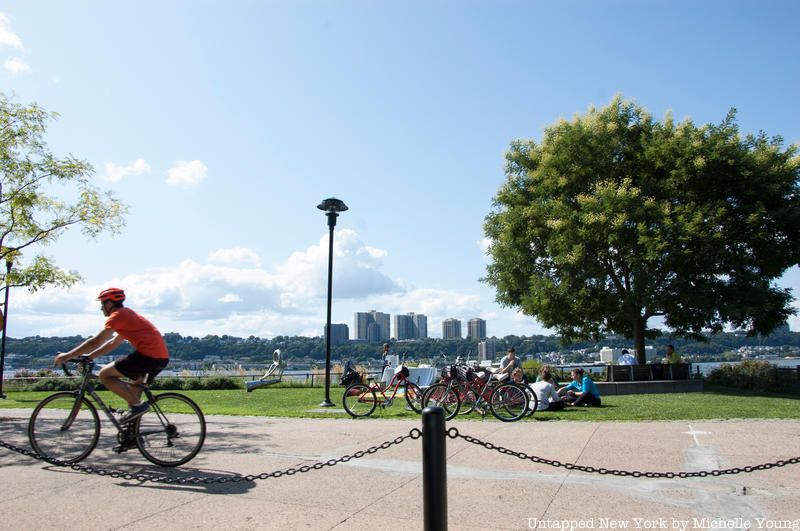
Harlem River Piers Park
Commissioner Silver: The one I’m most proud of in New York City, which most people don’t know I was involved in, was Harlem Piers Park. Many, many, many years ago when I was a consultant, the Giuiliani administration was working with a developer to put a big hotel commercial project right at the base of 125th Street in the Hudson River. I was hired by WE ACT to come up with a vision of an alternate plan, and I worked with a landscape architect called Tom Balsley, and he came up with a big vision called Harlem on the River. Make a long story short, we somehow were able to get Community Board 9, 10, and Manhattanville, the African Americans, the preservationists, the Dominicans all to agree on a plan for how it should be transformed. The Giuliani administration was not happy that we got that consensus and so I was not able to continue to work on the project but the NYCEDC took it on [and] did a study, hired a landscape architect and, ultimately, built what is now Harlem Piers Park. But a lot of the same elements we had suggested — extending piers, having water coming through — ultimately got built. That’s something that I thought was a David and Goliath story. It would have been sad had that building been built, because every other part of the community north and south had access, and that low point did not.
But in general, the one I’m most proud of is Raleigh Union Station, and the surrounding area. When I was working in Raleigh, it was just one of those dreams where it had been attempted before. We have a number of transit lines coming into this railyard. I was the third person to try to figure out how to get a transportation hub in our downtown and I succeeded. It took a lot of work, a lot of partners from the federal and the state. We even renamed it Raleigh Union Station — it was called something else before, and it opened up about a year ago. The entire neighborhood is now transformed — it’s called the Warehouse District. So that was something that I’m still to this day pinching myself because people laughed at me and said this cannot be done.
“I didn’t go to a prom. I never got to my junior year. My journey to get to where I am here today was not easy, but that’s the story.”
Commissioner Silver: I never finished high school. My journey to get to where I am here today was not easy, but that’s the story. I don’t share it often. One, I don’t want young people to think that they can drop out and end up like me. Those that I do share it with, I explain to the pain of that journey of having the stigma of having a GED and trying to get into a prestigious college, and how they laugh at you because your SAT scores aren’t great. It wasn’t that I was a bad student, my mother passed away when I was a child, I was angry at the world. But, it was a very difficult journey that in the end made me stronger, but I would not encourage people to take that path. It takes a lot of strength and resilience to be that far in a hole, climb out just to get to this level to get to the next level. It takes a lot and I would encourage people stay in school, get your degree, and then go on to college.
Commissioner Silver: Well, if it’s in planning, learn the art of communication. Communication is not just speaking, it’s listening. It’s observing, it’s spending time with the issue you’re most concerned about so you know how to respond. People are far too quick to jump to conclusions without doing their due diligence. For example, when I was a planner and I would go to a neighborhood to plan, I would spend many months just hanging out, talking to people, understanding the stories [and finding out] why this place is important. To me, that’s a form of communication. People think it’s just talking at you, but it’s observing and listening. And so, when I would start to have a conversation, I would reflect back on those stories and understand this is not just a building, memories happened in this building. And I’m able to communicate in a way that they understand. But you also want to make sure there’s no one size fits all. You have to tailor your communication skills to that audience. Age makes a difference. Culture makes a difference. All these things come into account and far too often I see people talking or communicating and not respecting that process enough. And so that was something very early in my career that I was determined to learn. You must understand your audience, you must be able to listen and you must be able to observe. And in that respect, can you become much better communicator.
Check out more interviews with NYC’s movers and shakers in our NYC Makers column.
Subscribe to our newsletter